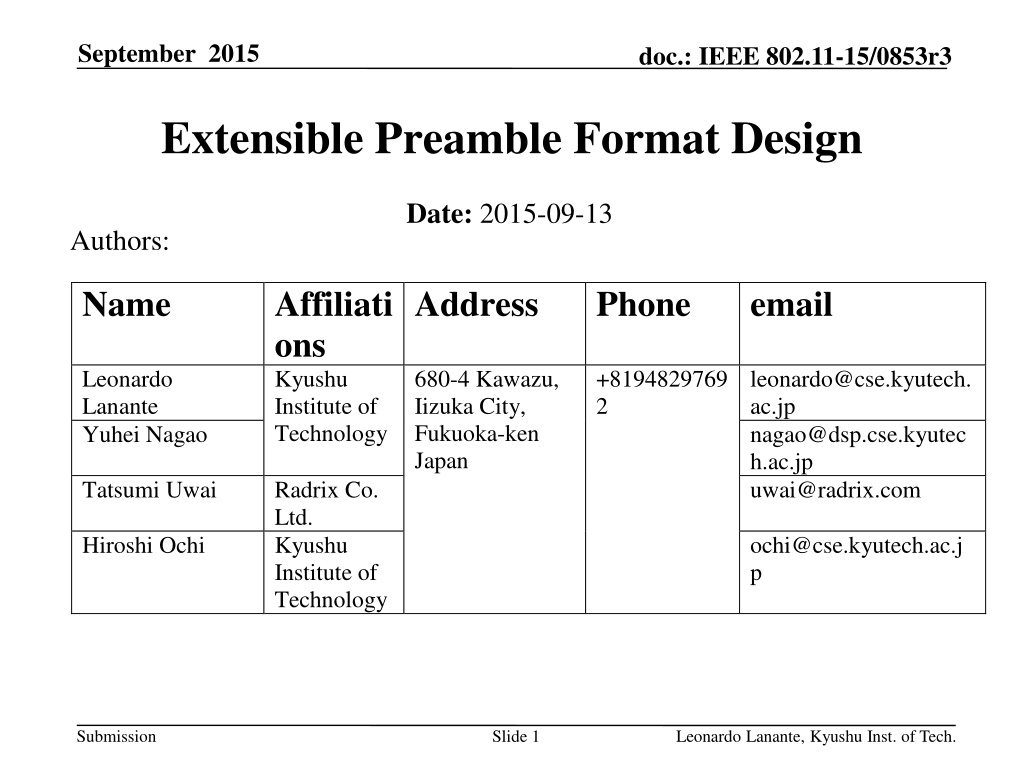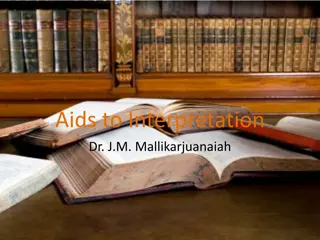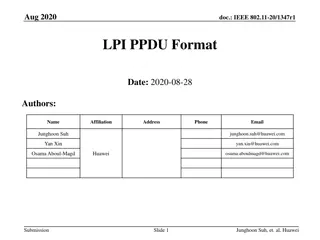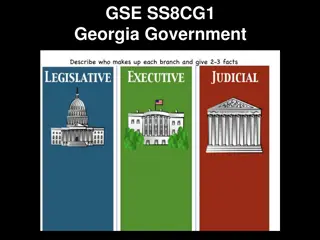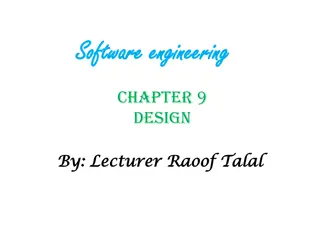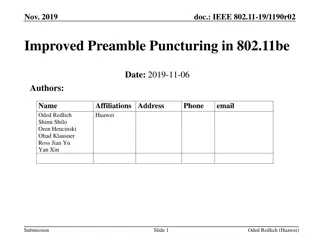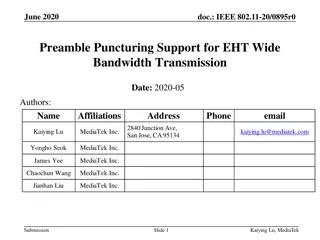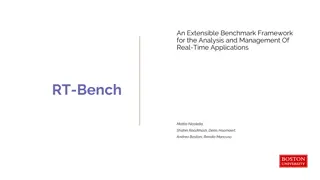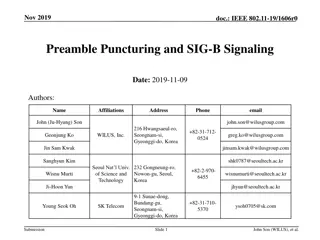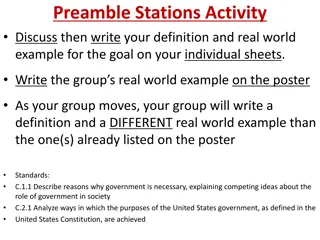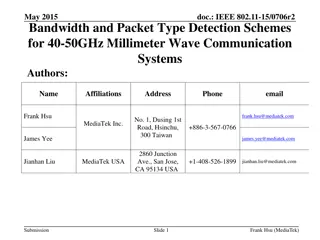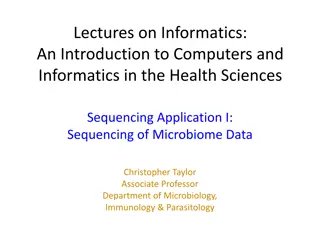Extensible Preamble Format Design
This document presents a proposal for a new extensible preamble format to address the challenges in detecting and differentiating PHY preamble formats in IEEE 802.11-15 standards. The proposed format aims to be efficient, straightforward, and easily extensible for future PHY amendments. By isolating and defining new preamble formats, this proposal ensures improved autodetection capabilities for current and upcoming standards.
Download Presentation

Please find below an Image/Link to download the presentation.
The content on the website is provided AS IS for your information and personal use only. It may not be sold, licensed, or shared on other websites without obtaining consent from the author.If you encounter any issues during the download, it is possible that the publisher has removed the file from their server.
You are allowed to download the files provided on this website for personal or commercial use, subject to the condition that they are used lawfully. All files are the property of their respective owners.
The content on the website is provided AS IS for your information and personal use only. It may not be sold, licensed, or shared on other websites without obtaining consent from the author.
E N D
Presentation Transcript
September 2015 doc.: IEEE 802.11-15/0853r3 Extensible Preamble Format Design Date: 2015-09-13 Authors: Name Affiliati ons Kyushu Institute of Technology Radrix Co. Ltd. Kyushu Institute of Technology Address Phone email Leonardo Lanante Yuhei Nagao 680-4 Kawazu, Iizuka City, Fukuoka-ken Japan +8194829769 2 leonardo@cse.kyutech. ac.jp nagao@dsp.cse.kyutec h.ac.jp uwai@radrix.com Tatsumi Uwai Hiroshi Ochi ochi@cse.kyutech.ac.j p Submission Slide 1 Leonardo Lanante, Kyushu Inst. of Tech.
September 2015 doc.: IEEE 802.11-15/0853r3 Summary Every time there is a new amendment requiring a new PHY preamble format, we always run into the problem of how to do the autodetection against all previous PHY preamble formats. We propose to create a new preamble format that is efficient and straightforward extensible for future PHY amendments. There have been a few proposals for the preamble format and its autodetection but they re extensibility is either uncertain or inefficient [1,2]. Submission Slide 2 Leonardo Lanante, Kyushu Inst. of Tech.
September 2015 doc.: IEEE 802.11-15/0853r3 Proposal- Develop an extensible new preamble format START Step 1: Isolate the New Preamble Format N STEP 1: New Format? Y Step 2: 11ac 11ax and future format detection Autodetection Step 2: Define an extensible encoding for 11ax and future extensions Submission Slide 3 Leonardo Lanante, Kyushu Inst. of Tech.
September 2015 doc.: IEEE 802.11-15/0853r3 Step 1: Isolating the new preamble format HE- SIG2 HE- SIG1 TBD L-LTF L-SIG L-STF BPSK BPSK BPSK 1. By using BPSK in the 2 symbols after L-SIG, we quickly narrow down the option to 11ax+ Legacy with BPSK modulated data 2. To rule out Legacy with BPSK, several approaches can be made [1-2]. CRC check Service Field Check Additional QBPSK symbol at the end of HE-SIG2 Special patterns in HE-SIG1 (Repeated L-SIG, Signatures) Submission Slide 4 Leonardo Lanante, Kyushu Inst. of Tech.
September 2015 doc.: IEEE 802.11-15/0853r3 Step 2: Define an extensible format to separate 11ax+ preamble formats HE- SIG2 HE- SIG1 TBD L-LTF L-SIG L-STF BPSK BPSK BPSK 1 TBD (actual 11ax-SIG bits) Propose a Prefix code for encoding the format 11ax indicator 01 TBD (actual 11bx-SIG bits) 11bx indicator 00 1 TBD (actual 11cx-SIG bits) 11cx indicator Note: 11bx, 11cx, etc. are future extensions Submission Slide 5 Leonardo Lanante, Kyushu Inst. of Tech.
September 2015 doc.: IEEE 802.11-15/0853r3 Benefits of Proposed Step 2 1. With Step 1, 11ax devices can readily distinguish its packet from 11ac and earlier packet formats. However with Step 2, it can also distinguish itself from future extensions. 2. Step 2 can either serve as an additional check for detecting 11ax preambles or a built in spoofing method that can be used by future ammendments. 3. Once the received frame is judged to be of the new format, detections of the future extensions have Accuracy - Equal to the BER of the L-SIG (or HE-SIG). This already has very good accuracy due to the Viterbi decoder. Extensibility- Only one bit overhead for 11ax. Additional bit per future extension. 4. By using a prefix code based encoding, we don t need to allot any bits for extensions that doesn t exist yet. Submission Slide 6 Leonardo Lanante, Kyushu Inst. of Tech.
September 2015 doc.: IEEE 802.11-15/0853r3 Updates for r2 1. Proposed Method applied to RLSIG method 2. Simulation Results 3. Other discussions Submission Slide 7 Leonardo Lanante, Kyushu Inst. of Tech.
September 2015 doc.: IEEE 802.11-15/0853r3 Proposed Method applied to RLSIG preamble TBD SIGA L-LTF L-SIG L-STF RL-SIG 11ax Reserved Bit 1 0 Value If FORMAT==HE otherwise Advantages 1. When all 11ax devices set this bit to 1, future devices using the same detection circuit will easily know that the packet is 11ax 2. Future devices can set 11ax reserved bit to 0 to avoid false detection by 11ax devices. Submission Slide 8 Leonardo Lanante, Kyushu Inst. of Tech.
September 2015 doc.: IEEE 802.11-15/0853r3 Autodetection Method START N Compare hamming distance (HD) with threshold L-SIG, RL-SIG repetition Y N LSIG Content Check Legacy detection Y 11ax Reserved Bit==1? N Y Future Standard Procedure 11ax Decode Procedure Submission Slide 9 Leonardo Lanante, Kyushu Inst. of Tech.
September 2015 doc.: IEEE 802.11-15/0853r3 Simulation Conditions 20MHz Bandwidth 1x1 antennas Channel D NLOS Real timing estimation, CFO, phase tracking RL-SIG repetition detection Hamming Distance threshold = [8,12,16,20] Submission Slide 10 Leonardo Lanante, Kyushu Inst. of Tech.
September 2015 doc.: IEEE 802.11-15/0853r3 False Detect Performance (11a) RLSIG + 11ax Reserved Bit check RLSIG only 0 0 10 10 L-SIG error Threshold=8 Threshold=12 Threshold=16 Threshold=20 L-SIG error Threshold=8 Threshold=12 Threshold=16 Threshold=20 -1 10 -1 10 -2 PER 10 -2 PER 10 -3 10 -3 10 50% Less errors -4 10 -4 10 -4 -2 0 2 4 6 8 10 -4 -2 0 2 4 6 8 10 SNR SNR Even against legacy devices, exactly 50% less false detect errors can be achieved) Submission Slide 11 Leonardo Lanante, Kyushu Inst. of Tech.
September 2015 doc.: IEEE 802.11-15/0853r3 False Detect Performance against Future devices If a future standard set the 11ax Reserved bit to zero, 11ax False Detection will improve with SNR regardless of the HD threshold. 0 10 L-SIG error Threshold=8 Threshold=12 Threshold=16 Threshold=20 -1 10 -2 PER No high SNR errors 10 -3 10 -4 10 -4 -2 0 2 4 6 8 10 SNR Submission Slide 12 Leonardo Lanante, Kyushu Inst. of Tech.
September 2015 doc.: IEEE 802.11-15/0853r3 Missdetect performance RLSIG only RLSIG + 11ax Reserved Bit check 0 0 10 10 L-SIG error Threshold=8 Threshold=12 Threshold=16 Threshold=20 L-SIG error Threshold=8 Threshold=12 Threshold=16 Threshold=20 -1 -1 10 10 -2 PER -2 PER 10 10 -3 -3 10 10 -4 -4 10 10 -4 -2 0 2 4 6 8 10 -4 -2 0 2 4 6 8 10 SNR SNR Some degradation at very high thresholds. But very high thresholds result in high false detect and hence must be avoided anyway. Submission Slide 13 Leonardo Lanante, Kyushu Inst. of Tech.
September 2015 doc.: IEEE 802.11-15/0853r3 Other discussions On Future extensibility - With the 11ax reserved bit, future WLANs will have the option to reuse 11ax autodetection circuit with the same performance. On the 11ax Reserved Bit Indicator - Based on our simulation, one bit is enough for the false detection error to track the LSIG PER curve (slide 12). Submission Slide 14 Leonardo Lanante, Kyushu Inst. of Tech.
September 2015 doc.: IEEE 802.11-15/0853r3 References [1] 11-15/0579, Preamble design and auto-detection, Hongyuan Zhang (Marvell) [2] 15/0081, Considerations on 11ax Auto-detection Methods, Jaeyoung Song (KAIST) Submission Slide 15 Leonardo Lanante, Kyushu Inst. of Tech.
